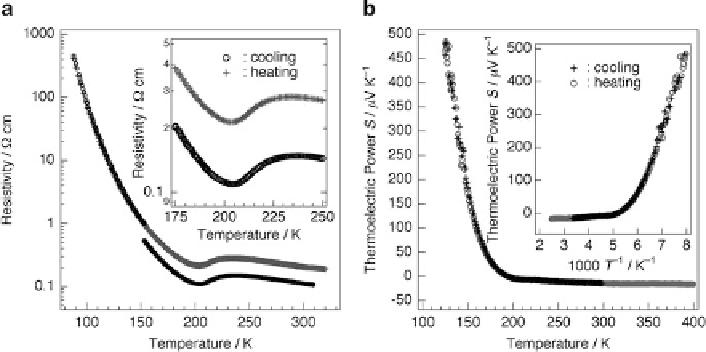Chemistry Reference
In-Depth Information
Fig. 9.12 (a) Temperature dependence of electrical resistivity measured along the chain axis
b
of
[Pt
2
(EtCS
2
)
4
I]
1
(2)[
32
]. (b) Temperature dependence of absolute thermoelectric power measured
along the chain axis
b
of 2
effective half-filled metallic band. The drastic change of
S
observed near 205 K
indicates that an energy gap at the Fermi energy is opened below 205 K. Below the
transition temperature, the thermoelectric power of 2 varies approximately as 1/
T
,
suggesting a semiconducting state [
62
-
64
]. These results demonstrate that the
compound 2 undergoes a metal-semiconductor transition at
T
M-S
¼
205 K.
Kitagawa et al. have reported the electrical resistivity of 2 under high pressure
[
65
,
99
]. The pressure dependences of the electrical resistivity of 2 along the
b
-axis (//
1D chain) are shown in Fig.
9.13
. Upon increasing the pressure, the resistivity at 298 K
decreases rapidly followed by a sharp transition at 3.0 GPa to a more resistive state and
a gradual decrease up to 8.0 GPa. The metallic conduction at 2.2 GPa is maintained
down to 70 K, that is, the metallic state is stabilized under pressure, surviving down to
70 K. The observed metal-semiconductor transition temperature (
T
M-S
¼
70 K) is the
lowest value in the 1D d-electronic conductors based on transition metal complexes.
The
T
M-S
of 2 is lowered by 140 K compared to KCP(Br) (
T
M-I
¼
210 K under
3.2 GPa) [
66
], and its 1D metallic state is more stabilized. Above 3.0 GPa, on the
contrary, the electrical transport behavior changed to be narrow gap semiconductor in
the whole temperature region, where the activation energies are 17 meV at 4.0 GPa
and 10 meV at 8.0 GPa. These results indicate that the resistivity jump at 3.0 GPa
is attributable to a pressure-induced metal-semiconductor transition. To clarify
the origin of the pressure-induced metal-insulator transition, X-ray oscillation
photographs have been taken under high pressure at room temperature. Any diffuse
scatterings or superlattice reflections at
k ¼ n
+ 0.5 (
n
being an integer) originating
from the twofold periodic valence ordering such as CDW or ACP states have not been
observed above 2.0 GPa, suggesting that the electronic state above 2.0 GPa is not
CDW or ACP but AV or CP state [
65
].

Search WWH ::

Custom Search